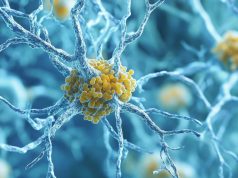Combining patient-reported questionnaire with AI increased the rate of new diagnoses by 31 percent versus usual care
By Lori Solomon HealthDay Reporter
MONDAY, Nov. 17, 2025 (HealthDay News) — Artificial intelligence (AI)-driven digital detection identifies Alzheimer disease and related dementias in primary care without costing physicians time or money, according to a study published online Nov. 10 in JAMA Network Open.
Malaz A. Boustani, M.D., from the Indiana University School of Medicine in Indianapolis, and colleagues evaluated the effect of the combined approach of the patient-reported Quick Dementia Rating System (QDRS) plus the Passive Digital Marker (PDM), a machine learning algorithm, in improving the annual rate of new documented ADRD diagnoses in primary care practices. The study involved nine federally qualified primary health care clinics (5,325 patients) that were randomly assigned to usual care (no routine screening for ADRD), PDM only, or QDRS plus PDM.
The researchers found that compared with the usual care clinics (12-month incidence, 12.4 percent), the odds of an incident ADRD diagnosis were higher in the clinics randomized to QDRS plus PDM (12-month incidence: 15.4 percent; adjusted odds ratio [aOR], 1.31; 95 percent confidence interval [CI], 1.05 to 1.64). A significant association was not seen among the clinics assigned to PDM only (12-month incidence: 10.3 percent; aOR, 0.84; 95 percent CI, 0.63 to 1.11). Similarly, the odds of ADRD diagnostic assessments were higher in the QDRS plus PDM clinics (12-month incidence: 36.7 percent; aOR, 1.41; 95 percent CI, 1.12 to 1.77) but not the PDM clinics (12-month incidence: 27.8 percent; aOR, 0.94; 95 percent CI, 0.72 to 1.22) compared with usual care clinics (12-month incidence: 29.0 percent).
“This is the most scalable approach to early detection that I know of,” Boustani said in a statement. “Most early detection methods require at least five minutes of a doctor’s time and often come with licensing fees. Our dual approach, by contrast, requires zero clinician time or money.”
Two authors disclosed ties to the pharmaceutical industry.
Copyright © 2025 HealthDay. All rights reserved.








